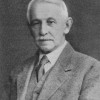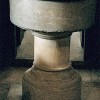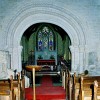Having regard to Dorset’s geographical situation as a coastal county we should not be surprised that numbered among its famous sons should be several master mariners. Sir George Somers was one of these mariners, but he occupied a key position among the county’s seafarers, rising from an obscure background to earn a reputation as a swashbuckling buccaneer of the ocean waves. And it was Somers who was to lay the foundations of what was to become the colonies of Virginia and Bermuda.
Somers was born in 1554, though it is not known for certain whether this was at Lyme or Whitchurch Canonicorum. Equally deficient is what is known of his earliest years, but he proved to be a worthy man of the sea, a bold adventurer in an age when England’s navy was effectively brought to birth under Tudor patronage. Somers therefore was there at the start of the great enterprise.
Ever since 1584 various abortive attempts have been made to colonise the North American territory which ultimately became Virginia. Somers too focussed his enormous energies in this direction, establishing in association with the Earl of Southampton and others, the London Virginia Company in 1606. He went on to command many naval expeditions to the Spanish Main, West Indies, and the Americas, and in 1597 joined Raleigh in a notable expedition to the Azores. On his return, however, he settled for some years back in Lyme Regis, where his notoriety seems to have helped in his election to Parliament when he stood to represent the town. He was elected Lyme’s Mayor two years later.
Somers did not remain at his home-base for long, for in 1609 he took command of an expedition to establish further settlers in the fledgling colony of Virginia (the name Virginia originally applied to all the colonial land along North America’s eastern seaboard until the designation of the 12 other states.) The colony of Roanoke had been founded only two years before. Jamestown and the voyage of the Mayflower to Cape Cod were to follow in 1620.
For this voyage Somers set sail in his Flagship Sea Venture. But after being at sea for two months the small fleet was struck by a hurricane, which dispersed the ships. Sea Venture thus became separated from the others and was damaged, causing it to spring a leak. Water then rose rapidly in the hold, but Somers’ exhausted crew were unable to cope with the flooding. For some time there was every likelihood the ship would sink.
Then Somers realised he was in reach of a group of islands not far away, encircled by a treacherous reef – a great danger in a rough sea. The coral shoals were much feared by Elizabethan sailors, who called them the “Isles of Devils”. Located 100 years earlier by a Spanish navigator, Juan Bermudeth, the islands were named in his honour. Somers and his crewmen would be stranded on Bermuda for 10 months.
Somers had to come to a decision whether to risk a landfall or perish on the reef. Spotting what appeared to be a sandy bay the captain drove the ship straight towards it, but the Sea Venture struck a pair of submerged rocks before becoming wedged between two further rocks. From this point the ship’s crew was able to disembark, without difficulty, as by then the storm had abated. The cargo was landed without loss, but Somers’ ship could not be saved. The shipwrecked crew also had a wholesome food supply and local fresh fish, birds and wild pigs. Clear, fresh water lay a few inches below ground. In fact, Somers and his men soon came to realise that the island was a virtual paradise, and set about constructing rudimentary dwellings using palmeto leaves.
The marooned mariners stayed on the island for almost a year, by which time some of them didn’t want to leave. But conscious of duty Somers and his officers set about repairing one of the Sea Venture’s boats in preparation for leaving. Fourteen men volunteered to make the 600-mile crossing to the mainland, but were lost on route and never heard from again. The rest of the crew with their captain managed to leave the island by constructing two pinnaces from cedars growing on the island. In May 1610 the party reached Virginia.
Before leaving, Somers took possession of the island for England, to be known as Somers Islands (they were re-named in honour of Bermudeth only later.) The captain was then made Admiral of Virginia, and with the colony suffering a severe food shortage, he sailed back to Britain to procure fresh supplies at the behest of Lord de la Warr. On the grocer’s errand however, Somers’ ship was again caught in a severe storm. Soon after returning to Bermuda, the great seaman sickened and died from eating, it has been said, an excessive amount of pig meat. The local coinage had a pig engraved on one side and a ship on the other.
After his death Somers’ heart was removed and buried in Bermuda. His body was brought back to England in a cedar chest because of a maritime superstition stored on board without the crew’s knowledge. The Admiral’s home at that time had been Berne Farm near Whitchurch Canonicorum. It is therefore fitting that this story should end where it began, with his burial beneath the old chantry in St. Andrews Church in Canonicorum.
In this part of Dorset Somers had long been regarded as Lyme’s most distinguished and respected citizen. It has been said that Shakespeare’s inspiration for the Tempest owes something to Somers’ adventures, in the likeness of Prospero and his island to Somers and Bermuda.
In 1996 Lyme was twinned with St.George in Bermuda. On the 23rd of July 1999 there was a commemorative parade in memory of Somers, leading onto the Cobb. Those attending the non-civic lunch were treated to the national drink of the Caribbean island: a blend of dark rum and ginger beer known locally as Dark ‘n’ Stormy.



